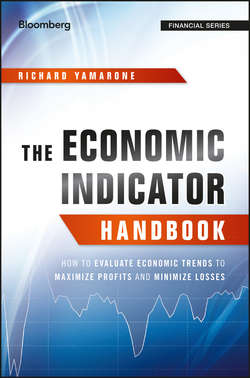Читать книгу The Economic Indicator Handbook - Ричард Ямароне - Страница 13
На сайте Литреса книга снята с продажи.
Chapter 1
The Daily Blotter
The Powerful Economic Workbench
ОглавлениеExhibit 1.7 displays the Bloomberg Economic Workbench. Basically, this is a charting tool. Any of the historical data on the terminal may be loaded into a field and then altered to identify a particular pattern or association. Sometimes economists want to compare data that are reported in different bases, like a quarterly GDP and weekly initial jobless claims, or daily commodity prices and monthly producer price indexes.
Exhibit 1.7 Economic Workbench
Source: Bloomberg
In Exhibit 1.7, we chart the U.S. Treasury cash balance of federal tax deposits withheld from employment income and tax receipts against the monthly nonfarm payrolls. The economic explanation behind this is that the more people employed, the greater will be the amount of tax withholdings by the federal government.
There are several other applications that analysts like to apply to data such as moving averages – especially for volatile economic time series or for high frequency daily or weekly data. Year-over-year analysis of indicators is often the best perspective used on the Street, since this smooths so many fluctuations that may occur in data that are presented week-to-week, month-to-month, or quarter-to-quarter. In this book, the majority of data are presented on a year-over-year basis.
Other transformations frequently used in economic analysis are aggregation, whereby data points are summed or averaged. There are times when only the last data point of the month is desired. In addition, the analyst might like to perform many different applications like absolute values, logarithms, exponential, and power transformations.
Because economic indicators can adopt a leading, lagging, or coincident nature, the ability to transform the data by leading or lagging a few periods is also a common analytical tool that economists perform on data. Some indicators are lagged by sizable periods – five or six months, or even a year. You'll want to be able to make these adjustments to the many indicators.
Nearly all of the major trading floors have a morning squawk. During this internal broadcast, market participants – particularly those on the trading floor – are alerted to the top events, earnings announcements, and economic data.
Basically, this is a condensed and informative interpretation of the events and economic calendars. Discussions about potential market trends and possible market conditions are also mentioned. This is also a forum for analysts to pitch ideas, as well as investment products and securities, to the salespeople. Bloomberg has a version called the First Word Audio Squawk, and can be accessed on the terminal by typing SQUAWK <GO>.
Another type of communication on the Street is called the hoot-and-holler, whereby an economist would analyze the economic releases as they hit the tape. Admittedly, these instant analyses were much more prevalent in the 1970s through 1990s, but there are a few trading institutions that carry on this live interpretation of the data.
The task of the hoot-and-holler is not one for an amateur and is extremely difficult; a mere slip can cost traders millions. You have to be aware of the underlying market conditions, particularly the fixed-income market, and you must know what the Street expectations for the release are. It's also important to know how the markets will react to economic releases.
